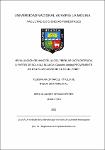Mostrar el registro sencillo del ítem
Evaluación de nanocelulosa fibrilar (NCF) obtenida a partir de Bolaina blanca (Guazuma crinita) proveniente de una plantación de Ucayali, Perú
| dc.contributor.advisor | Cárdenas Oscanoa, Aldo Joao | |
| dc.contributor.advisor | Gonzales Mora, Héctor Enrique | |
| dc.contributor.author | Arango Perez, Sergio Andre | |
| dc.date.accessioned | 2022-11-28T19:56:06Z | |
| dc.date.available | 2022-11-28T19:56:06Z | |
| dc.date.issued | 2022 | |
| dc.identifier.uri | https://hdl.handle.net/20.500.12996/5528 | |
| dc.description | Universidad Nacional Agraria La Molina. Facultad de Ciencias Forestales. Departamento Académico de Manejo Forestal | es_PE |
| dc.description.abstract | El objetivo del presente estudio fue obtener y caracterizar nanocelulosa fibrilar (NCF) de la madera de bolaina blanca (Guazuma crinita Mart) a diferentes alturas del eje longitudinal del fuste de árboles de una plantación de tres años y medio; proveniente de la región Ucayali. La NCF fue obtenida mediante molienda mecánica usando un molino planetario de bolas. Se caracterizó el producto mediante técnicas analíticas: SEM, XRD, TGA, FTIR, UV-Vis, además, se halló el grado de polimerización. Se evaluó el efecto de la posición longitudinal en las características de la NCF mediante la comparación de medias, evaluadas en pruebas estadísticas de ANOVA y Kruskal – Wallis. El rendimiento de la producción de NCF a partir de la sección apical, media y basal fue de 32,1; 33,6 y 31 por ciento, respectivamente. La NCF obtenida obtuvo un diámetro significativamente mayor para la zona apical (84 nm) en comparación a la zona media (75 nm) y basal (69 nm), las cuales no mostraron significancia entre sí; la longitud se mantuvo por encima de la micra; con respecto al grado de polimerización, se encontraron valores entre los 200 y 300 monómeros de glucosa que componen la red celulósica, donde la zona basal presenta valores significativamente mayores a la zona media y apical, respectivamente. El producto mostró un polimorfismo típico de celulosa tipo I y con índices de cristalinidad con valores de 76, 93 y 96 por ciento para la sección apical, media y basal, respectivamente. Con respecto a la termoestabilidad de la NCF, se obtuvo una tasa de degradación máxima entre los 335 °C y 341 °C, siendo la NCF proveniente de la zona basal la más estable. Se evaluó el poder de adsorción de la NCF sobre tinte de azul de metileno, donde se encontró una eficiencia por encima del 60 por ciento | es_PE |
| dc.description.abstract | The objective of this study was to obtain and characterize nanofibrillated cellulose (NCF) from the wood of bolaina blanca (Guazuma crinita Mart) at different heights of the longitudinal axis of the trunk of trees from a three-and-a-half-year-old plantation from the Ucayali region. The NCF was obtained by mechanical milling using a planetary ball mill. The product was characterized by analytical techniques: SEM, XRD, TGA, FTIR, UV-Vis, in addition, the degree of polymerization was found. The effect of the longitudinal position on the NCF characteristics was evaluated by means of the comparison of means, evaluated in ANOVA and Kruskal - Wallis statistical tests. The effciency of NCF production from the apical, middle and basal sections was 32.1, 33.6 and 31 percent, respectively. The NCF obtained acquire a significantly larger diameter for the apical zone (84 nm) compared to the middle (75 nm) and basal zone (69 nm), which did not show significance among themselves; the length remained above the micron; with respect to the degree of polymerization, values were found between the 200 and 300 glucose monomers that compose the cellulosic network, where the basal zone presents significantly higher values than the middle and apical zone, respectively. The product showed a typical type I cellulose polymorphism and crystallinity indexes with values of 76, 93 and 96 percent for the apical, middle and basal sections, respectively. Regarding NCF thermostability, a maximum degradation rate was obtained between 335 °C and 341 °C, with the NCF coming from the basal zone being the most stable. The adsorption power of NCF on methylene blue dye was evaluated, where an efficiency above 60 percent was found. | en_US |
| dc.format | application/pdf | en_US |
| dc.language.iso | spa | es_PE |
| dc.publisher | Universidad Nacional Agraria La Molina | es_PE |
| dc.rights | info:eu-repo/semantics/openAccess | en_US |
| dc.rights.uri | https://creativecommons.org/licenses/by-nc-nd/4.0/ | * |
| dc.subject | Bolaina blanca | es_PE |
| dc.subject | Guazuma crinita | es_PE |
| dc.subject | Celulosa | es_PE |
| dc.subject | Nanofibras | es_PE |
| dc.subject | Ucayali (dpto) | es_PE |
| dc.title | Evaluación de nanocelulosa fibrilar (NCF) obtenida a partir de Bolaina blanca (Guazuma crinita) proveniente de una plantación de Ucayali, Perú | es_PE |
| dc.type | info:eu-repo/semantics/bachelorThesis | en_US |
| thesis.degree.discipline | Ciencias Forestales | es_PE |
| thesis.degree.grantor | Universidad Nacional Agraria La Molina. Facultad de Ciencias Forestales | es_PE |
| thesis.degree.name | Ingeniero Forestal | es_PE |
| dc.subject.ocde | https://purl.org/pe-repo/ocde/ford#2.05.07 | es_PE |
| renati.author.dni | 76466244 | es_PE |
| dc.publisher.country | PE | es_PE |
| dc.type.version | info:eu-repo/semantics/publishedVersion | en_US |
| renati.advisor.orcid | https://orcid.org/0000-0003-3093-8414 | es_PE |
| renati.advisor.dni | 41581709 | es_PE |
| renati.type | https://purl.org/pe-repo/renati/type#tesis | es_PE |
| renati.level | https://purl.org/pe-repo/renati/level#tituloProfesional | es_PE |
| renati.discipline | 821016 | es_PE |
| renati.juror | Trujillo Cuellar, Florencio Teodoro | |
| renati.juror | Araujo Flores, Martín | |
| renati.juror | Montenegro Muro, Rolando Antonio |
Ficheros en el ítem
Este ítem aparece en la(s) siguiente(s) colección(ones)
-
CFO-MF Tesis [241]





